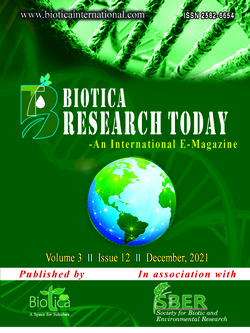
Zinc Deficiency and Its Corrective Measures in Fruit Crops
P. Malathi
Dept. of Soil Science and Agricultural Chemistry, Tamil Nadu Agricultural University, Coimbatore, Tamil Nadu (641 003), India
K. M. Sellamuthu*
Dept. of Natural Resource Management, Horticultural College and Research Institute (Tamil Nadu Agricultural University), Periyakulam, Tamil Nadu (625 604), India
K. Sivakumar
Dept. of Soil Science and Agricultural Chemistry, Tamil Nadu Agricultural University, Coimbatore, Tamil Nadu (641 003), India
DOI: NIL
Keywords: Fruit crops, Specific symptoms, Zinc deficiency, Zinc toxicity
Abstract
Zinc in essential for human health and it is necessary for the immune system. Zinc sufficient plants contain 25 to 150 ppm of Zn in mature tissue. Zinc (Zn) deficiency is widespread throughout the world causing economic losses on fruit crops. It commonly affects banana, custard apple and mangoes. Problems often appear in spring when crops are growing quickly but have difficulty in absorbing nutrients from cold soil. Zinc is required for the synthesis of tryptophan a precursor of auxin thus helps in reducing fruit drop. Plants absorb zinc as Zn2+. Zinc deficiency leads to fruit loss of 25 percent to no yield. To correct zinc deficiency, zinc has to be applied by soil application as enriched manures, through drip fertigation as water-soluble fertilizers and foliar application when there is deficiency symptom occurs or whenever necessary to achieve the maximum benefit.
Downloads
not found
Reference
Deshpande, J.D., Joshi, M.M., Giri, P.A., 2013. Zinc: The trace element of major importance in human nutrition and health. International Journal of Medical Science and Public Health 2, 1-6.
Swietlik, Dariusz, 2001. Zinc Nutrition of Fruit Crops. Horticultural Technology 12(1), 45-50.
TNAU AGRITECH PORTAL, 2015. Available at: https://agritech.tnau.ac.in/horticulture/horti_min_nutri_fruits.html. Accessed on: 28.12.2021.
